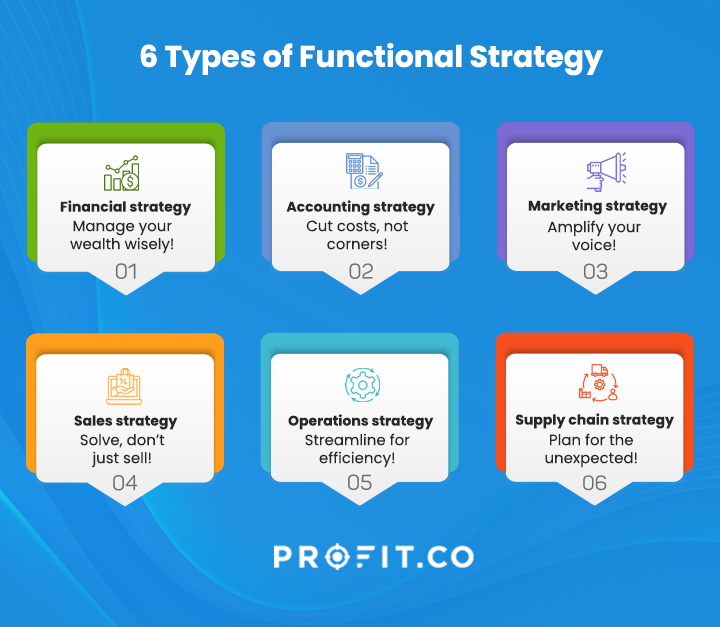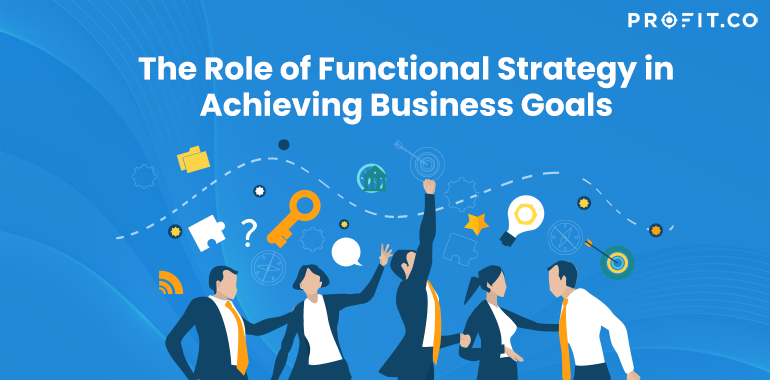Introduction
Strategic planning is a vital process for any business, but it can also be a waste of time if not done properly. According to Gartner, business executives say that 56% of the time spent on strategic planning is wasted. How can functional leaders ensure that their strategic planning is productive and aligned with the business goals? The answer is functional strategy.
Functional strategy is not only important for each function but also for the whole organization. When the functional strategies are aligned and integrated, they create a powerful synergy that propels the business forward. Each function contributes to the value creation and competitive advantage of the business, while also collaborating and coordinating with other functions to ensure harmony and consistency. Functional strategy is the essence of organizational excellence.
In this article, we will explore the significance of functional strategy in achieving business success. We will provide insights into how to develop and implement effective and efficient functional strategies for each department, and how to harmonize them with the broader business strategy and goals. By understanding and fine-tuning these strategies, you will be able to enhance your operational performance, secure your competitive edge, and fulfill your business aspirations.
Understanding Functional Strategy
Functional strategy is the set of specific, focused actions and plans that each department or function within a company develops and implements to support the overall business strategy and objectives. It is different from corporate strategy, which defines the overall direction and scope of the company, and business-level strategy, which determines how the company competes in its chosen markets. Functional strategy is more concerned with how each function performs its tasks and activities to contribute to the company’s success.
6 Types of Functional Strategy
Functional strategy is important because it helps align the actions and goals of each function with the overall business goals. It ensures that each function is working towards the same vision and mission and that they are coordinated and integrated with each other.

Finance and Accounting Functional Strategy
Finance and accounting are the functions that manage the company’s financial resources and transactions. It is responsible for planning, organizing, controlling, and reporting the financial activities and performance of the company. Finance and accounting support the business goals by providing accurate and timely financial information, analysis, and advice to the management and other stakeholders. It also helps the company achieve its financial objectives, such as profitability, growth, and stability.
Examples of finance and accounting strategies
Finance and Accounting Functional Strategies are essential for managing a company’s financial health and ensuring compliance with financial regulations. Here are some real-life examples that demonstrate these strategies:
Microsoft’s Capital Allocation Strategy: Microsoft’s approach to finance involves prudent capital allocation, ensuring that its investments yield optimal returns. The company strategically balances its portfolio between research and development, acquisitions, dividends, and share buybacks. This strategy not only supports growth but also maximizes shareholder value, demonstrating effective financial stewardship.
Berkshire Hathaway’s Value Investing Approach: Led by Warren Buffett, Berkshire Hathaway’s finance and accounting strategy revolves around value investing. The company carefully analyzes potential investments, focusing on long-term growth and intrinsic value rather than short-term market trends. This approach involves meticulous financial analysis and disciplined accounting practices, contributing to the firm’s substantial growth and profitability over the years.
Apple’s Tax Strategy: Apple’s financial strategy includes efficient tax planning. The company has been known for utilizing various legal avenues to minimize its tax liabilities, such as locating subsidiaries in countries with lower tax rates. This strategy, while controversial, reflects a complex understanding of international finance and tax laws, helping Apple to maximize its profits.
General Electric’s (GE) Diversification and Risk Management: GE’s finance strategy historically involved diversification across multiple industries, which was complemented by a robust risk management approach. This strategy allowed the company to balance risks and rewards across different sectors, maintaining financial stability even in turbulent markets. However, in recent years, GE has shifted its strategy to focus more on its core businesses, demonstrating adaptability in its financial planning.
Starbucks’ Financial Reporting and Sustainability Initiatives: Starbucks emphasizes transparency in its financial reporting, integrating corporate social responsibility (CSR) into its financial strategy. The company provides detailed reports on its sustainability initiatives and social impact, aligning its financial goals with broader social objectives. This approach not only fosters trust among investors and customers but also demonstrates how financial strategies can be aligned with ethical and environmental considerations.
“Manage the top line: your strategy, your people, and your products, and the bottom line will follow.”
Marketing and Sales Functional Strategy
Many marketing leaders struggle to see the results of their strategic plans. According to Gartner, only 13% of marketing leaders have seen results from their strategic plans. How can marketing and sales leaders improve their strategic planning and execution? The answer is marketing and sales functional strategy.
A marketing and sales functional strategy is a plan that aligns the activities of the marketing and sales departments with the overall business objectives. It helps to define the target market, the value proposition, the marketing mix, and the sales process for a product or service. It also helps to measure and improve the performance of the marketing and sales functions by using metrics and feedback mechanisms.
Examples of marketing and sales functional strategy
Marketing and Sales Functional Strategies are pivotal in driving business growth, brand recognition, and customer engagement. Here are some real-life examples that showcase these strategies effectively:
Coca-Cola’s Global Branding Strategy: Coca-Cola’s marketing strategy is a prime example of successful global branding. The company has created a universally recognizable brand through consistent messaging, iconic advertising campaigns, and strategic sponsorships. Coca-Cola’s ability to adapt its marketing to local cultures while maintaining a consistent global brand image demonstrates a highly effective international marketing strategy.
Nike’s Just Do It Campaign: Nike’s “Just Do It” campaign is an iconic example of a sales and marketing strategy that connects with consumers on an emotional level. The campaign, which focuses on inspiring athletes of all levels, has helped Nike to position itself as more than just a product but as a symbol of motivation and perseverance. This emotional branding strategy has been instrumental in driving sales and reinforcing Nike’s position as a leader in the athletic apparel market.
Apple’s Premium Pricing Strategy: Apple’s marketing and sales strategy involves positioning its products as premium and aspirational, which justifies its higher price points. The company’s focus on innovative design, high-quality materials, and a seamless user experience, combined with effective marketing, has created a strong brand loyalty. This strategy not only drives sales but also establishes Apple products as a status symbol
Spotify’s Freemium Model and Personalized Playlists: Spotify’s marketing strategy includes offering a freemium model where users can access basic services for free but pay for premium features. This strategy is complemented by personalized playlists and recommendations, which enhances user experience and engagement. By leveraging data to understand user preferences and create custom content, Spotify not only retains users but also effectively converts free users to paid subscribers.
Ready to learn more about achieving continuous learning for your organization?
Operations and Supply Chain Functional Strategy
Operations and Supply Chain Functional Strategy is a topic that deals with how a business manages its operations and supply chain activities to achieve its strategic goals and objectives. It involves planning, designing, implementing, and controlling the processes and resources that create and deliver value to customers and stakeholders.
Examples of operations and supply chain functional strategy
Operations and Supply Chain Functional Strategy are crucial elements in business, focusing on optimizing processes to ensure efficient production, distribution, and service delivery. Here are some real-life examples that illustrate these strategies:
IKEA’s Cost-Efficient Supply Chain: IKEA’s operations strategy focuses on cost-efficiency and sustainability. The company designs its products in a way that they can be flat-packed, reducing shipping costs significantly. IKEA also sources materials close to its manufacturing facilities to minimize transportation costs and carbon footprint, exemplifying an efficient and environmentally conscious supply chain strategy.
McDonald’s Supply Chain and Operations Management: McDonald’s excels in supply chain and operations management, ensuring consistent quality and service across its global outlets. The company implements a tightly integrated supply chain with rigorous standards to manage its network of suppliers. McDonald’s also uses a sophisticated logistics system to ensure fresh ingredients are delivered timely to its restaurants, which is critical for maintaining food quality and customer satisfaction.
Zara’s Fast-Fashion Supply Chain: Zara’s approach to supply chain management is central to its business model. The company can design, produce, and get clothing to stores in just a few weeks, much faster than traditional fashion retailers. This is achieved through a highly responsive supply chain that allows Zara to quickly react to changing fashion trends and consumer demands, keeping inventory fresh and reducing markdowns.
FedEx’s Use of Technology in Operations: FedEx showcases an advanced use of technology in its operations and supply chain. The company utilizes a highly sophisticated logistics infrastructure that includes real-time package tracking, automated sorting systems, and optimized route planning. This high-tech approach enhances efficiency in package handling and delivery, setting a high standard in the courier and logistics industry.
Final Thoughts
In summary, functional strategy plays a crucial role in bridging the gap between a company’s overarching objectives and the day-to-day operations of its various departments. It’s about aligning each function’s unique strengths and capabilities with the organization’s broader vision, mission, and values. This alignment is key in driving value creation and securing a competitive edge in today’s fast-paced and multifaceted market landscape. The careful planning, execution, and ongoing evaluation of functional strategies are imperative for any business aspiring to thrive. By adeptly managing these strategies, a business meets its current goals and sets the stage for sustained growth and exceptional performance in an ever-evolving corporate world.

